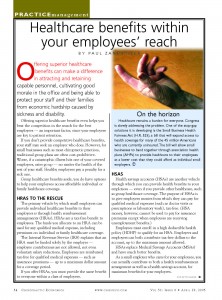
Chiropractic Economics
CHIROPRACTIC ECONOMICS – APRIL 6, 2005
Offering superior healthcare benefits can make a difference in attracting and retaining capable personnel, cultivating good morale in the office and being able to protect your staff and their families from economic hardship caused by sickness and disability.
By Paul Zane Pilzer
If you don’t provide competitive healthcare benefits, your staff may seek an employer who does. However, for small businesses such as most chiropractic practices, traditional group plans are often cost-prohibitive. Worse, if a catastrophic illness hits one of your covered employees, rates go up — no matter the health of the rest of your staff. Healthy employees pay a penalty for a sick one.
Group healthcare benefits aside, you do have options to help your employees access affordable individual or family healthcare coverage.
HRAs TO THE RESCUE
The primary vehicle by which small employers can provide individual healthcare benefits to their employees is through health reimbursement arrangements (HRAs). HRAs are a tax-free benefit to employees. The funds you allocate to an HRA can be used for any qualified medical expense, including premiums on individual or family healthcare coverage.
The Internal Revenue Service (IRS) explains that an HRA must be funded solely by the employer — employee contributions are not allowed, not even voluntary salary reductions. Employees are reimbursed tax-free for qualified medical expenses — such as insurance premiums — up to a maximum dollar amount for a coverage period.
If you offer an HRA, you must provide the same benefit to everyone within a class of employees.
ON THE HORIZON
Healthcare remains a burden for everyone. Congress is slowly addressing the problem. One of the stop-gap solutions it is developing is the Small Business Health Fairness Act (H.R. 525), a bill that will expand access to health coverage for many of the 45 million Americans who are currently uninsured. The bill will allow small businesses to band together through association health plans (AHPs) to provide healthcare to their employees at a lower cost than they could afford as individual small employers.
HSAs
Health savings accounts (HSAs) are another vehicle through which you can provide health benefits to your employees — even if you provide other healthcare, such as group healthcare coverage. The purpose of HSAs is to give employees monies from which they can pay for qualified medical expenses (such as doctor visits or prescriptions or laboratory work), tax-free. (HSA money, however, cannot be used to pay for insurance premiums except when employees are receiving unemployment benefits.)

